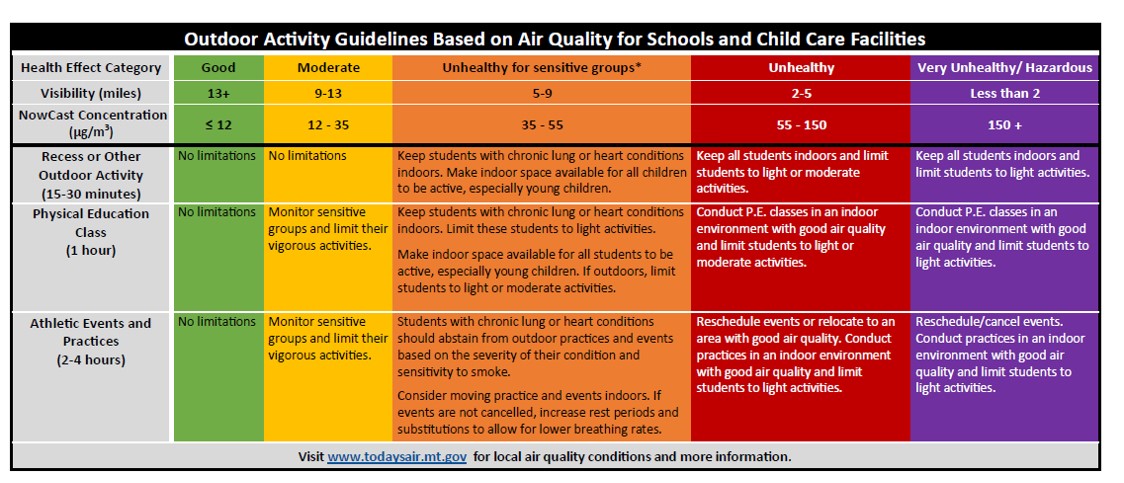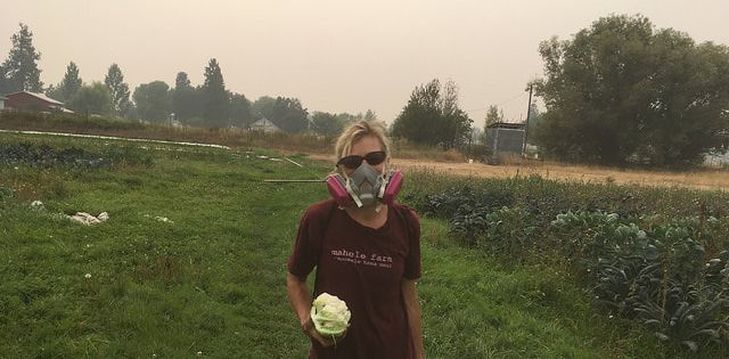We all like to play outside. Many Montanans also work outside for a living and are not able to stay indoors during wildfire smoke. Explore this page for more about what you can do if you have to be outdoors.
Outdoor Physical Activity
We all need fresh air, sunlight, and exercise. During periods of wildfire smoke, it's easy to feel unhappy or trapped when we're told to stay indoors or reduce physical activity, and when we can't see the sun through the smoke. Health officials know this, which is why it's important to find a balance that works for you, given the ever-changing conditions. Here are some tips for youth sports and for any outdoor enthusiast trying to staying sane and active:
- Plan big outdoor adventures for spring and early summer (June and July).
- Find a local gym that filters their air effectively (if deemed safe to use gyms given COVID-19 in your location).
- Make a list of indoor activities you've been meaning to accomplish and save them for August/September (books, movies, art projects, household projects, cooking projects, etc.).
- When the smoke arrives, check daily and hourly air quality measurements and forecasts so that you can get outside when air quality is best, or even go to the healthiest locations nearby.
- If you are training for a sport, plan to have a flexible down or recovery week for late August or September.
- Significantly reduce strenuous outdoor exercise when wildfire smoke is labeled unhealthy - pushing through it may cause damage to your health that outlasts the smoke.
The following recommendation chart has been created by Montana DEQ, DPHHS, and Public Instruction as an advisory.
worker concerns
Are you a farmer? Rancher? Construction worker?
What are the risks of working outside in smoke?
People who work outside during smoke, and especially those doing strenuous physical labor are at high risk for experiencing symptoms and unwanted health impacts of smoke exposure. If you have asthma or lung disease be extra careful working outside - carry an emergency inhaler, a phone, and let someone know where you are. Take breaks frequently. Physical symptoms of smoke exposure might include coughing, dry or sore throat, and headaches (click here for more information on health impacts and symptoms of smoke exposure). Outdoor workers may experience more severe mental health impacts of smoke, such as feelings of hopelessness or depression. Pay attention to your body and mood, and talk to your doctor if you are concerned.
What can I do about it?
Tons of Montanans make their living outside, and when the smoke rolls in - there's no air filter that can clean out the office, so to speak. But there are ways to relieve your lungs and reduce smoke exposure symptoms.
Some ways to improve health for outside workers:
What are the risks of working outside in smoke?
People who work outside during smoke, and especially those doing strenuous physical labor are at high risk for experiencing symptoms and unwanted health impacts of smoke exposure. If you have asthma or lung disease be extra careful working outside - carry an emergency inhaler, a phone, and let someone know where you are. Take breaks frequently. Physical symptoms of smoke exposure might include coughing, dry or sore throat, and headaches (click here for more information on health impacts and symptoms of smoke exposure). Outdoor workers may experience more severe mental health impacts of smoke, such as feelings of hopelessness or depression. Pay attention to your body and mood, and talk to your doctor if you are concerned.
What can I do about it?
Tons of Montanans make their living outside, and when the smoke rolls in - there's no air filter that can clean out the office, so to speak. But there are ways to relieve your lungs and reduce smoke exposure symptoms.
Some ways to improve health for outside workers:
- Create a clean indoor space that you can escape to for at least a few hours each day (ideally your sleeping room, so that you have multiple hours of clean breathing each night) - go to the Clean Indoor Air page to learn how to create a clean air space.
- If possible, take your breaks inside, in a place with at least some filtration (either with a portable filter or cooling system running on recirculate).
- Talk to your employer about providing air filters for your indoor office or for your home if you work outside all day.
- Wear a particulate respirator outside when air quality is "unhealthy" and you aren't able to work indoors.
- On your days off - spend as much time as possible in cleaner air, whether that be an indoor filtrated space, or a non-smoky location out of town.
Be prepared! Create a clean air space before wildfire season begins:
Purchase a HEPA air purifier or a particulate respirator (see below).
Purchase a HEPA air purifier or a particulate respirator (see below).
Particulate Respirators and masks
What works:
The best choice to make during heavy wildfire smoke is to reduce physical activity and spend as much time as you can in clean indoor air. However, many Montanans work outside on farms or ranches and are unable to stay indoors. In this case, there are still some ways we can reduce health impacts. If you are unable to stay indoors during heavy wildfire smoke, read below for information on protective masks and respirators.
Note that respirator masks should be a last resort, as they are difficult to fit correctly, decrease oxygen intake, are hot, and can easily leak when worn improperly.
This is what to look for when purchasing a mask:
The best choice to make during heavy wildfire smoke is to reduce physical activity and spend as much time as you can in clean indoor air. However, many Montanans work outside on farms or ranches and are unable to stay indoors. In this case, there are still some ways we can reduce health impacts. If you are unable to stay indoors during heavy wildfire smoke, read below for information on protective masks and respirators.
Note that respirator masks should be a last resort, as they are difficult to fit correctly, decrease oxygen intake, are hot, and can easily leak when worn improperly.
This is what to look for when purchasing a mask:
- Certified NIOSH ("NIOSH" will be written somewhere on the filter material)
- N95 or N100 type mask
- Get a mask with TWO straps, one that goes around over your ears, and one under the ears and around the head
- Choose a size that will fit over your nose and under your chin. It should seal tightly to your face. If you cannot get a close face seal, try a different model or size
|
What doesn't work
|
Who should NOT use particulate respirator masks
- Children! Respirators are not sized for children and therefore won't be as effective
- People with previous respiratory issues including asthma
- People who are not physically fit may experience difficulty going about daily tasks due to reduced oxygen intake. It is more important to have enough oxygen than to have clean air - if you are using a respirator and feel faint, nauseous, or have trouble breathing, take the mask off.
- People with heart or lung disease should consult with their doctor before using a respirator.
How Do I Use my Respirator Mask?
- Place the respirator over your nose and under your chin, with one strap below the ears and one strap above (see photo above). If you’re wearing a hat, it should go over the straps.
- Pinch the metal nose clip tightly over the top of your nose.
- Facial hair will cause the respirator to leak, so you should be clean-shaven.
- Take frequent breaks, especially if you are working in the heat or doing heavy work. It takes more effort to breathe through a respirator, and can also increase the risk of heat stress.
- If you feel dizzy, lightheaded, or nauseated, tell someone, go to a less smoky area, remove your respirator, and get medical attention.
- Discard the respirator when: (1) it becomes more difficult to breathe through it, or (2) if the inside becomes dirty. If necessary, use a fresh respirator each day.
- Keep your respirator clean and dry. Be sure to read and follow the manufacturer’s recommendations on use and storage
See California's Protect Your Lungs from Wildfire Smoke information sheet for a downloadable set of instructions on what kind of respirator to buy and how to use it.






